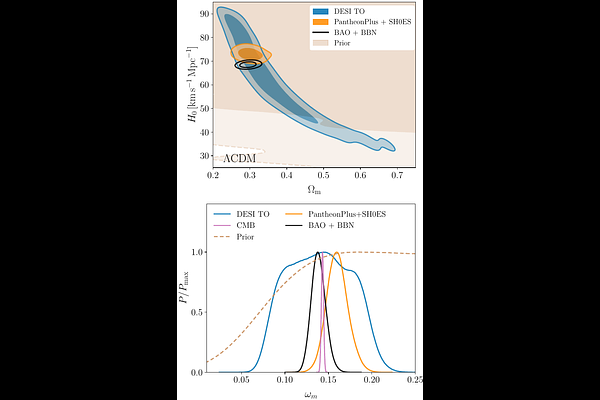Model-Independent Measurement of the Matter-Radiation Equality Scale in DESI 2024

Model-Independent Measurement of the Matter-Radiation Equality Scale in DESI 2024
B. Bahr-Kalus, D. Parkinson, K. Lodha, E. Mueller, E. Chaussidon, A. de Mattia, D. Forero-Sánchez, J. Aguilar, S. Ahlen, D. Bianchi, D. Brooks, T. Claybaugh, A. Cuceu, A. de la Macorra, P. Doel, A. Font-Ribera, E. Gaztañaga, S. Gontcho, A Gontcho, G. Gutierrez, K. Honscheid, D. Huterer, M. Ishak, R. Kehoe, S. Kent, D. Kirkby, T. Kisner, A. Kremin, O. Lahav, M. Landriau, L. Le Guillou, C. Magneville, M. Manera, P. Martini, A. Meisner, R. Miquel, J. Moustakas, S. Nadathur, N. Palanque-Delabrouille, W. J. Percival, F. Prada, I. Pérez-Ràfols, A. J. Ross, G. Rossi, L. Samushia, E. Sanchez, D. Schlegel, M. Schubnell, H. Seo, J. Silber, D. Sprayberry, G. Tarlé, B. A. Weaver, R. Zhou, H. Zou
AbstractThe peak of the matter power spectrum, known as the turnover (TO) scale, is determined by the horizon size at the time of matter-radiation equality. This scale can serve as a standard ruler, independent of other features in the matter power spectrum, such as baryon acoustic oscillations (BAO). Here, we present the first detection of the turnover in the galaxy auto-power spectrum, utilising the distribution of quasars (QSO) and luminous red galaxies (LRG) measured by the Dark Energy Spectroscopic Instrument (DESI) during its first year of survey operations in a model-independent manner. To avoid confirmation bias, we first analyse the data using data blinding methods designed for the DESI baryon acoustic oscillation, redshift space distortion and scale-dependent bias signals. We measure the angle-averaged dilation distance $D_V(z = 1.651) = (38.1\pm 2.5)r_H$ from the quasars and $D_{V}(z = 0.733) = (21.8\pm 1.0)r_H$ from the LRG sample in units of the horizon $r_H$ at the matter-radiation-equality epoch. Combining these two constraints and assuming a flat $\Lambda$CDM model with three standard neutrino species, we can translate this into a constraint of $\Omega_{m}h^2 = 0.139^{+0.036}_{-0.046}$. We can break the $\Omega_m$-$H_0$ degeneracy with low-redshift distance measurements from type-Ia supernova (SN) data from Pantheon+, we obtain a sound-horizon free estimate of the Hubble-Lema\^itre parameter of $H_0=65.2^{+4.9}_{-6.2}$ km/s/Mpc, consistent with sound-horizon dependent DESI measurements. On the other hand, combining the DESI BAO and TO, we find a truly DESI-only measurement of $H_0=74.0^{+7.2}_{-3.5}$ km/s/Mpc, in line with DESI-only full-shape results where the sound-horizon scale is marginalised out. This discrepancy in $H_0$ can be reconciled in a $w_0w_a$CDM cosmology, where the combination of DESI BAO and TO data yields $H_0 = 66.5\pm 7.2\;\mathrm{km/s/Mpc}$.